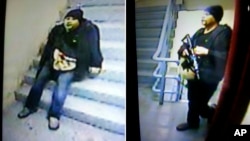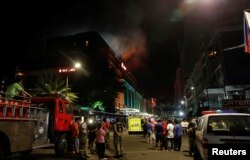The Islamic State terror group appears to be engaging in a war of words with Philippine authorities, insisting an attack on a casino in Manila was the work of one of its fighters.
Philippine officials have repeatedly downplayed any possible links between the deadly incident at the Resorts World Manila complex early Friday and IS, describing it as a botched robbery.
But nearly 24 hours after the incident which killed 36 people, most from smoke inhalation after the gunman set fires to the inside the gambling hall, the terror group issued not one but two separate claims through official channels.
The first of the claims, by the Amaq news agency, cited an attack by “Islamic State fighters.”
A subsequent statement through the group’s Nashir news agency named just one, "Brother Abu al-Khayr” who it said “infiltrated a gathering of Christians with his assault rifle…where he caused them death and humiliation until he was martyred."
So far, Philippine officials have portrayed the claims as a reach.
"All indications point to a criminal act by an apparently emotionally disturbed individual," Ernesto Abella, a spokesman for the Philippine president, told reporters. "Although the perpetrator gave warning shots, there apparently was no indication that he wanted to do harm or shoot anyone."
Bolstering the claims of Philippine officials is the idea that the incident did not follow the conventional model for IS attacks, often aimed at maximizing death and destruction.
U.S. intelligence officials have also raised concerns in the past about what they see as an increasing desire by IS to claim attacks, regardless of the group’s involvement, in order to keep alive a narrative of continued momentum.
“There is no publicly available evidence so far to suggest this attack was an external operation coordinated by members of the Islamic State,” according to Jade Parker, a senior research associate at the Terror Asymmetrics Project on Strategy, Tactics and Radical Ideologies (TAPSTRI), who has studied IS’ cyber capabilities.
“The failure of IS media officials to align their messaging suggests that the group's foreknowledge of the event in Manila was minimal,” Parker added.
Other analysts remain cautious, saying that while the incident in Manila does not seem to follow the standard IS model of aiming for maximum death and destruction, other elements can be found in IS propaganda.
“We’re expecting ISIS to function here the way we want them to work,” according to Raphael Gluck, an independent researcher. “Did anyone hear him shout anything in Arabic? Is there a video of his allegiance pledge?”
Gluck said the terror group’s Rumiyah magazine, for example, has called for the use of arson and encouraged followers to take wealth or spoils from their enemies.
But whether IS ultimately played a role in the attack on the Manila casino, the incident underscores long-standing concerns about the group in Southeast Asia.
IS "has called on followers in Southeast Asia to go to the Philippines if they cannot travel to Syria," according to a U.S. intelligence official who spoke to VOA on condition of anonymity.
IS nucleus
Some researchers have warned of the "creation of an IS nucleus,” with a growing focus on the Philippines.
And some Philippine officials suggest IS groups may be getting a boost from foreign terrorist fighters, one decrying fighting in the southern part of the country as an "invasion by foreign terrorists."
Western intelligence officials have been hesitant to discuss just how many IS fighters have made the journey from Iraq, Syria and elsewhere to the Philippines. But a new report by the Combatting Terrorism Center at West Point warns IS’ core leadership appears be exerting its influence.
“Forty-five percent of Islamic State-linked attacks and plots in the region had financial and communication ties to Southeast Asian Islamic State operatives in Syria where group members sought to enable and guide attacks remotely,” the report said.
Australian intelligence officials also believe there is a significant danger, worried the region could become a magnet for would-be jihadists and foreign fighters as Islamic State’s fortunes continue to wane in Iraq and Syria.
And potential barriers to using the Philippines or other nearby areas as a base for IS operations may be overblown.
"The disadvantage to Southeast Asia is it's remote and ethnically a lot of ISIS fighters would stick out," said Daveed Gartenstein-Ross, a senior fellow at the Washington-based Foundation for Defense of Democracies. "But all of that was true also of Afghanistan when al-Qaida made it its center of gravity."










